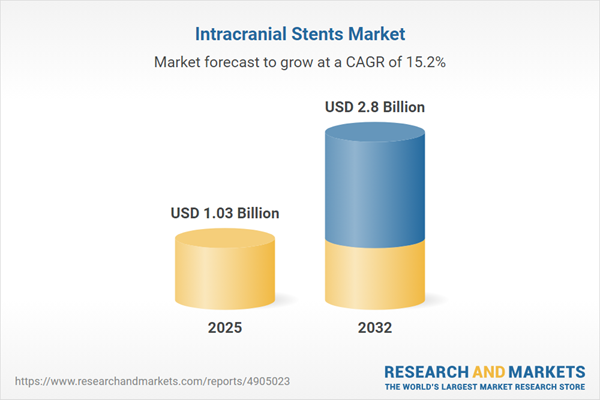Speak directly to the analyst to clarify any post sales queries you may have.
The intracranial stents market is advancing rapidly as healthcare organizations prioritize minimally invasive neurovascular interventions. Senior stakeholders are re-evaluating approaches to optimize workflows, clinical outcomes, and market strategy, guided by operational imperatives and shifting sector expectations.
Intracranial Stents Market Snapshot
The global intracranial stents market is valued at USD 903.51 million and is expected to reach USD 1.03 billion by 2025, showing a compound annual growth rate of 15.19%. By 2032, the market is projected to reach USD 2.80 billion. Progress is fueled by the widespread adoption of advanced neurovascular procedures and the ongoing modernization of stent design, incorporating advances in imaging and navigation technologies. Evolving reimbursement environments are streamlining value chains and broadening treatment access. Market leaders respond by integrating new technologies and refining supply and distribution strategies, allowing rapid adaptation to shifting clinical priorities and healthcare models within the neurointerventional landscape.
Scope & Segmentation of the Intracranial Stents Market
- Product Types: Includes balloon-expandable, self-expanding, braided, and laser cut stents, supporting customized intervention for varied vascular anatomies and complex clinical requirements.
- Material Types: Manufactured from cobalt chromium, nickel titanium (nitinol), and stainless steel, these devices deliver the flexibility and durability needed for both routine and challenging neurovascular cases.
- Coating Types: Devices may be bare metal or drug-eluting, with options such as paclitaxel or sirolimus coatings to lower procedural risks and address a broad spectrum of patient indications.
- Indications: Treats saccular and fusiform aneurysms as well as cerebral vessel stenosis, addressing requirements for minimally invasive therapies and supporting a diverse patient base.
- End Users: Utilized primarily by hospitals and neurointerventional clinics, where procedural efficiency and specialized staff training are central to care quality improvement.
- Distribution Channels: Marketed through direct sales, e-commerce, dedicated field teams, and established distributors to ensure prompt device availability across varied care settings.
- Geographic Regions: Presence spans the Americas, Europe, Middle East & Africa, and Asia-Pacific, with region-specific strategies shaped by local regulatory policies and procurement norms.
- Key Companies Profiled: Sector progress is led by organizations including Medtronic plc, Stryker Corporation, Cerenovus LLC, MicroPort Scientific Corporation, Terumo Corporation, Balt Extrusion S.A.S., Acandis GmbH, Phenox GmbH, Boston Scientific Corporation, and InspireMD Ltd., all contributing to industry research and local market development.
Key Takeaways for Senior Decision-Makers
- Advanced stent technologies empower clinicians to address complex neurovascular disorders and tailor therapies to nuanced patient profiles, enabling more effective, targeted management.
- Efficiencies in supply chain management enhance consistent product access, supporting uninterrupted operations even amid global logistical changes and market shifts.
- Evolving procurement strategies focus on practitioner education, robust device support, and strong supplier collaborations, building foundations for sustainable organizational value.
- Modernized regulatory pathways are accelerating the adoption of innovative stent solutions, enabling organizations to align swiftly with the latest compliance and quality standards.
- Digital solutions, including remote monitoring and automated inventory, are increasing procurement precision and strengthening manufacturer-provider links to better meet changing clinical demands.
- Ongoing industry and research partnerships continue to spur material science advancements and artificial intelligence integration, supporting evidence-based clinical protocols and optimized resource utilization.
Tariff Impact on Supply Chain and Procurement
Recent changes in medical device tariffs are impacting procurement and supply chain approaches throughout the intracranial stents sector. Organizations are enhancing supplier partnerships and investing in infrastructure to ensure resilient product access and streamlined operations.
Methodology & Data Sources
This report is based on interviews with neurointerventional surgeons, procurement specialists, and regulatory experts. Insights are bolstered with scientific literature review, laboratory performance data, and information from recent product launches, delivering a reliable overview of current market realities.
Why This Report Matters for Strategic Planning
- Equips executive teams to anticipate neurovascular market shifts, refine strategies, and proactively address operational risks and emerging opportunities.
- Provides actionable frameworks for adapting to regulatory and procurement developments, supporting timely, informed decision-making.
- Supplies clear guidance on market segmentation, go-to-market models, and best-practice integration, fostering effective participation across evolving regions and technology landscapes.
Conclusion
Sustained success in the intracranial stents market depends on continuous innovation, process agility, and technology integration, ensuring organizations remain competitive amid sector evolution and changing clinical needs.
Additional Product Information:
- Purchase of this report includes 1 year online access with quarterly updates.
- This report can be updated on request. Please contact our Customer Experience team using the Ask a Question widget on our website.
Table of Contents
3. Executive Summary
4. Market Overview
7. Cumulative Impact of Artificial Intelligence 2025
Companies Mentioned
The companies profiled in this Intracranial Stents market report include:- Medtronic plc
- Stryker Corporation
- Cerenovus LLC
- MicroPort Scientific Corporation
- Terumo Corporation
- Balt Extrusion S.A.S.
- Acandis GmbH
- Phenox GmbH
- Boston Scientific Corporation
- InspireMD Ltd.
Table Information
| Report Attribute | Details |
|---|---|
| No. of Pages | 184 |
| Published | October 2025 |
| Forecast Period | 2025 - 2032 |
| Estimated Market Value ( USD | $ 1.03 Billion |
| Forecasted Market Value ( USD | $ 2.8 Billion |
| Compound Annual Growth Rate | 15.1% |
| Regions Covered | Global |
| No. of Companies Mentioned | 11 |









